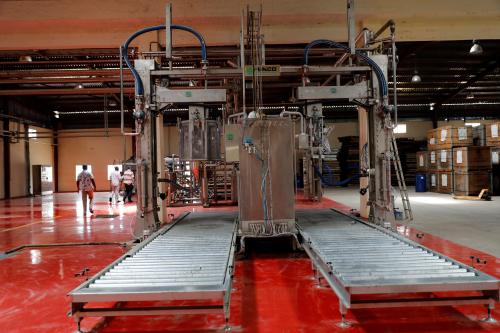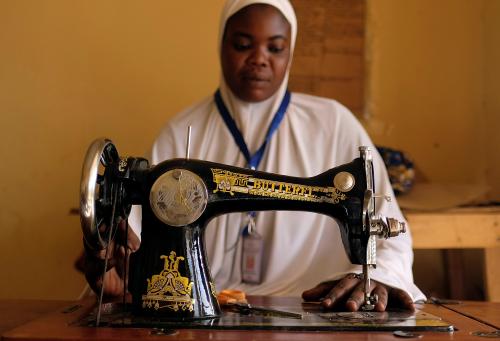Below is a viewpoint from Chapter 4 of the Foresight Africa 2018 report, which explores six overarching themes that provide opportunities for Africa to overcome its obstacles and spur inclusive growth. Read the full chapter on African structural transformation here.
One of the key challenges sub-Saharan African countries must address is the need to undergo structural transformation in the face of young and growing labor forces. As such, there are the twin imperatives of many economies: First, the need to grow, and second, the need to provide employment opportunities for their growing populations.
Although there is evidence of growth-inducing structural transformation in sub-Saharan Africa since the 2000s, this has not been manufacturing led as it was in the “East Asian model.” Using the empirical technique employed by McMillan, Rodrik, and Verduzco-Gallo (2014), Figure 4.4 depicts sub-Saharan Africa’s pattern of structural transformation in the post-2000 period. There is a shift of labor resources away from low productivity agriculture activities (in the bottom left quadrant). However, instead of substantial labor resources shifting toward high productivity manufacturing activities, much of the shift has been directed toward services-based activities, such as government services and retail services.

In contrast, the “East Asian model,” depicted in Figure 4.5, shows manufacturing-led structural transformation with a substantial shift of labor resources toward a relatively large manufacturing sector (in the top right quadrant). Broadly speaking, this manufacturing-led growth has not occurred in sub-Saharan Africa. A key question, is why?

We posit that sub-Saharan African countries have low levels of economic complexity, which negates their ability to structurally transform (Bhorat, Rooney, and Steenkamp, 2016). Figure 4.6 shows the relationship between economic development and economic complexity, and it is evident that higher levels of economic complexity are associated with higher levels of economic development. Economic complexity measures the productive know-how or capabilities inherent in an economy, and in order for a country to diversify into more complex productive activities—particularly those in manufacturing—it needs to accumulate productive capabilities. More complex countries are able to produce a diversity of more complex products, such as x-ray machines, while less complex countries are typically restricted to a concentrated portfolio of resource-based products, such as iron ore. It is clear from the clustering of sub-Saharan African countries in the lower-left segment of Figure 4.6 that these countries are characterized by low levels of economic complexity or limited productive capabilities, which constrains their ability to structurally transform.

How can a country build economic complexity?
Building complexity, and thus producing a diverse range of increasingly complex manufacturing products, is a path-dependent process. This is best illustrated and explained using the Product Space analytical framework developed by Hidalgo, Klinger, Barabási, and Hausmann (2007). Countries shift more easily to products characterized by capabilities that are similar to those embedded in a country’s current productive structure. For example, it is easier to shift production from iron ore to steel than it is to shift from iron ore to pharmaceuticals. Thus, if a country produces relatively low complexity natural resource-based products, as many African countries do, the capabilities inherent in these products are relatively dissimilar to those needed to produce complex manufacturing products, meaning the ability to diversify, and hence structurally transform, is curtailed.
The link between building complexity and employment creation is not a simple direct relationship; rather, it is nuanced. Increasingly complex products tend to be more capital- and technology-intensive, and thus the employment multipliers get lower for the most complex products (Bhorat, Kanbur, Rooney, and Steenkamp, 2017). However, in industrial terms, many African countries are starting from low bases, and thus the manufacturing products closest in terms of required capabilities are relatively less capital-intensive. Thus, African countries can build complexity by developing more diverse productive structures, characterized by a greater number of manufacturing activities, and thereby generate employment opportunities.
However, a key constraint to this process of building complexity in African countries is their current set of productive capabilities. These are distant from those needed in order to shift to more complex productive activities. For example, the shift to higher value-added agriculture, such as horticulture, may be constrained by the lack of scientific know-how needed to produce products that meet food standards in developed country markets. Shifting to manufacturing activities may be constrained by skills shortages or lack of access to financial, logistics, and input networks.
Building complexity, and thus producing a diverse range of increasingly complex manufacturing products, is a path-dependent process.
With the notion that building complexity is a path-dependent process shaped by the capabilities embedded in a country’s productive structure, policymakers could do the following: First, using the Product Space and Economic Complexity analytical framework, identify products with capabilities similar to those inherent in a country’s current productive structure. For example, if a country is producing motor vehicles, then the next product space would be vehicle parts. Second, test whether these products align with economic reality. This is done by speaking to industry associations, firms, and other public and private sector stakeholders in order to test whether the outcomes of the analytical framework align with what is happening in the economy. Third, identify appropriate target markets. For example, determine whether exports are to be directed toward high- or low-income markets, or international or regional markets.
The employment creation potential of building complexity is dependent upon the production function specific to each new industry. However, this process of diversifying toward a wide range of increasingly complex productive activities, by its very nature, will generate employment opportunities for sub-Saharan African countries.
REFERENCES
Bhorat, H., R. Kanbur, C. Rooney, and F. Steenkamp. 2017. “Sub-Saharan Africa’s Manufacturing Sector: Building Complexity.” African Development Bank Working Paper Series No 256. Abidjan, Côte d’Ivoire: African Development Bank Group. https://www.afdb.org/fileadmin/uploads/afdb/Documents/Publications/WPS_No_256_Manufacturing__Employment-Complexity_Analysis_Zc_.pdf.
Bhorat, H., C. Rooney, and F. Steenkamp. 2016. “Africa’s Manufacturing Malaise.” United Nations Development Programme (UNDP) Regional Bureau for Africa Working Paper Series, Vol.1, No. 3. New York, NY: UNDP. http://jobsanddevelopmentconference.org/wp-content/uploads/2016/10/STEENKAMPAfricas- Manufacturing-Malaise.pdf.
Hidalgo, C.A., B. Klinger, A.-L. Barabási, and R. Hausmann. 2007. “The Product Space Conditions the Development of Nations.” Science 317(5837): 482- 287. http://science.sciencemag.org/content/317/5837/482.
McMillan, M., D. Rodrik, and I. Verduzco-Gallo. 2014. “Globalization, Structural Change, and Productivity Growth, with an Update on Africa.” World Development 63(1): 11-32. http://drodrik.scholar.harvard.edu/files/dani-rodrik/files/globalization_structural_change_productivity_growth_with_africa_update.pdf.







Commentary
Foresight Africa viewpoint – Manufacturing complexity in Africa
February 5, 2018